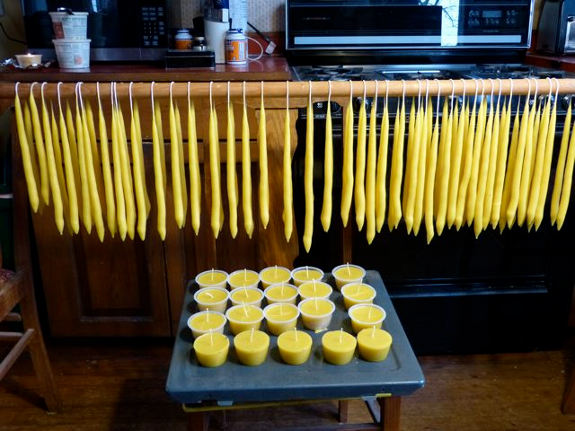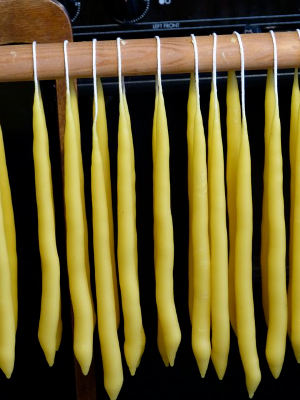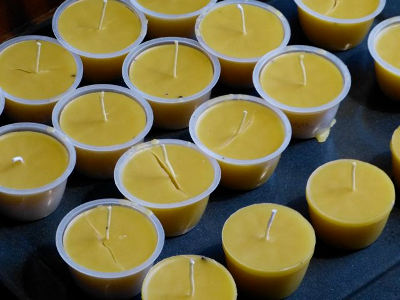
How to dip homemade candles

 If you keep bees, you end up
with lots of wax. Folks who like comb honey or who manage top bar hives will have much more, but
even those of you who use an extractor will collect a lot of
cappings.
If you keep bees, you end up
with lots of wax. Folks who like comb honey or who manage top bar hives will have much more, but
even those of you who use an extractor will collect a lot of
cappings.
Our movie star neighbor
solved the excess beeswax problem by making 110 candles. (He
hasn't quite figure out how to solve the excess candles problem....)
The first step was to
clean the beeswax. He melts his wax in an olive oil can partially
full of water atop a pot of boiling water, then uses a seive to dip out
any gunk that floats to the surface. (This waxy debris makes
great firestarters, our neighbor points out.) After the wax is
mostly clean, pour it into a five gallon bucket to cool, then pour off
the water once the wax has solidified. You should be able to pop
the solid wax right out of your bucket, but then will need to scrape
more gunk off the bottom until you're left with beautiful, clean wax.
Knock the wax into
chunks with a hammer and melt it again in a fresh olive oil can, still
atop a pot of boiling water. If you don't want to mess your
kitchen up, lay down some newspapers, and also set up a broom or other
pole between two chairs. Cut wick material (about $2 for more
than you'll ever use) into lengths twice as long as you want your
finished candles to be. Then start dipping.

If your wax is the
perfect temperature, it will coat the wick thickly but won't drip off
excessively. A little cooler is generally better than a little
hotter since cooler wax stays on much better --- you'll know if you've
gone too cold because the wax will be a bit chunky.
Our neighbor found it
useful to keep three cans of wax melting at all times, pouring melted
wax into the foremost can so that it was always full enough to dip a
candle.
After dunking the wick
the first time, wait until the wax is partly cool, then stretch the
candle out with your fingers so that the candle straightens. You
may need to repeat this procedure after the second dipping as well, but
after that, you can just dip, cool, and dip again.
You'll notice in the
pictures that our neighbor makes two candles out of each wick.
This method makes it easy for him to drape the candles over his rod and
let them cool between dippings. Later, he'll cut the wick and end
up with a pair of candles.
 Our neighbor dipped each
candle about 25 to 30 times, which means it took him six to seven hours
(and about two gallons of clean wax) to make 80 candles plus 30 tea
lights. The tea lights were to use up excess wax at the end of
the project and are made from a small piece of wick inside a cleaned
out applesauce container.
Our neighbor dipped each
candle about 25 to 30 times, which means it took him six to seven hours
(and about two gallons of clean wax) to make 80 candles plus 30 tea
lights. The tea lights were to use up excess wax at the end of
the project and are made from a small piece of wick inside a cleaned
out applesauce container.
Previous batches of
handmade candles have gone to the Harvest
Table Restaurant,
where they were priced at $5 per pair. However, our neighbor
notes that they didn't sell nearly as well as honey (which went like
hotcakes.) On the other hand, the yellow, honey-scented candles
hanging on his wall always attract the attention of guests, so he's had
no problem giving them away to loving homes.
Want more in-depth information? Browse through our books.
Or explore more posts by date or by subject.
About us: Anna Hess and Mark Hamilton spent over a decade living self-sufficiently in the mountains of Virginia before moving north to start over from scratch in the foothills of Ohio. They've experimented with permaculture, no-till gardening, trailersteading, home-based microbusinesses and much more, writing about their adventures in both blogs and books.
Want to be notified when new comments are posted on this page? Click on the RSS button after you add a comment to subscribe to the comment feed, or simply check the box beside "email replies to me" while writing your comment.

I used to make candles that way at Girl Scout Camp! Only we did it over a fire, of course.
If your neighbor is interested, I'd bet those candles would sell like hotcakes on Etsy. (In case you're unfamiliar, it's a website for listing and selling handmade and vintage goods.)
I'm glad I found your blog yesterday. We moved out to a 10 acre place in Texas 3 months ago. I enjoy reading what other people have experienced. We're just starting our journey, but I can't think of a better place to be.
I'm reading your blog from the beginning. I just started 2009... don't tell me how it ends. lol
Tony
Jayne --- I'll send you each others' email addresses. I suspect he'd be glad to sell you some candles.
Bubbles --- Etsy's a good idea --- definitely the perfect spot for reaching an audience of folks interested in handmade crafts.
Tony --- Good luck with your new adventure! I hope you enjoy reading from the beginning (but keep in mind we'd already been on the blog for a few years at the point the blog starts. I wish we'd really documented from the beginning!)